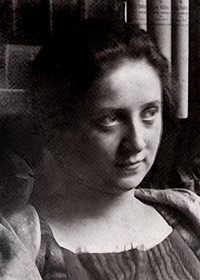Friedl Dicker-Brandeis
(Vienna 1898 – Auschwitz 1944): An art teacher in a concentration camp
Giving hope to children
Friedl Dicker-Brandeis grew up in a relatively poor Jewish family in Vienna. Her mother died when she was just four years old and this is often viewed as the catalyst for her extraordinary dedication to teaching art to children. During the First World War, Friedl Dicker-Brandeis attended the Vienna private school of the painter and art theorist Johannes Itten, whom she followed to the Bauhaus in Weimar in 1919. As a politically progressive artist, she wanted to contribute to creating a more socially just world through her work. From 1923 she worked in Berlin and Vienna, where she was temporarily imprisoned in 1934 for her political activities, after which she worked in Prague and Hronov, Bohemia. She was versatile and multi-talented: a painter, a producer of children’s toys and textile works, a costume designer for the theatre, a cover designer for books, furniture and architectural designs. In Vienna she taught art for kindergarten education. After the Nazis assumed power in Germany, she became involved in art education for refugee children from Nazi Germany.
Despite her many talents and creative works, she met the same fate as many female artists of her time, being largely disregarded and forgotten for many years. However, anyone dealing with the history of Theresienstadt concentration camp and the children’s drawings created there cannot fail to come across her. She was interned there in 1942, together with her husband Pavel Brandeis. In the two years that followed, she became enormously important to the children interned at the camp, as she gave them drawing classes despite the lack of materials. She had already gained teaching experience in Vienna and was geared towards reform pedagogy. One hallmark of her work with children was the great attention she paid to children’s ingenuity, accompanying them as they discovered their own creativity. There were many valuable traces left by her work: not only the children’s drawings, but also the positive memories of the children who survived, although they were traumatised by the events. The drawing lessons were not only about the children expressing their hope and gaining self-confidence through drawing, but also about them being able to put aside their fears in the drawings for a brief moment as a kind of therapeutic intervention.
Eva Štichová-Beldová, who worked as Friedl Dicker-Brandeis’ assistant in the summer of 1944, recalled: “During so-called free time, no topic was prescribed, the children were not even supposed to think – just draw, collect themselves, dream and then draw again, whatever came out of it. The aim of these hours was spontaneous expression that led to the liberation of the mind. [...]”
(Fritzsch, p. 75)
When her husband was deported to Auschwitz, Friedl Dicker-Brandeis volunteered to go on a “transport”. She was deported from Theresienstadt to Auschwitz on 6 October 1944 with transport Eo, no. 167. Of the 1,550 deportees, only 112 survived; the others were murdered, among them Friedl Dicker-Brandeis on 9 October 1944. Her husband survived.
Literature
Katrin Fritzsch, Friedl Dicker-Brandeis. Bauhausschülerin, Malerin, Pädagogin, dissertation, Vienna 2010.
Julie M. Johnson, The Other Legacy of Vienna 1900: The Ars Combinatoria of Friedl Dicker-Brandeis. In: Austrian History Yearbook 51 (2020), p. 243–268.
Elena Makarova, Friedl Dicker-Brandeis. Ein Leben für Kunst und Lehre, Vienna-Munich 1999.

